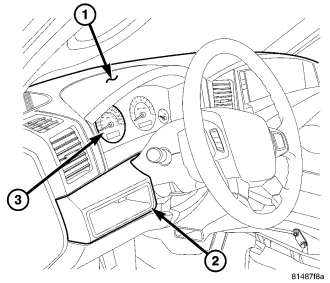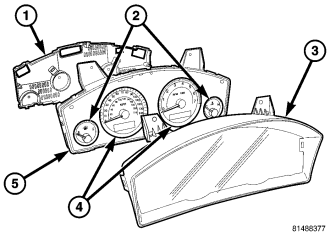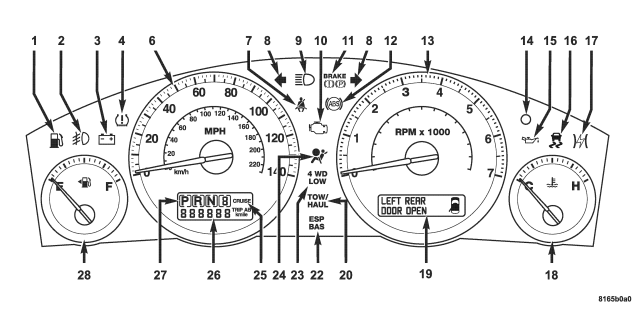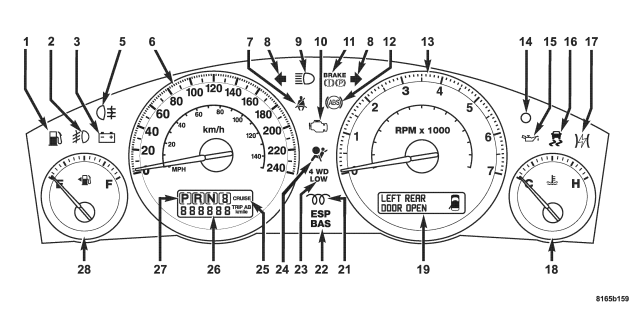DESCRIPTION

The instrument cluster (3) for this vehicle is an ElectroMechanical Instrument Cluster (EMIC) that is located in the instrument panel above the steering column opening, directly in front of the driver. The remainder of the EMIC, including the mounts and the electrical connections, are concealed within the instrument panel below the cluster hood (1). The instrument cluster for this vehicle also includes the hardware and software necessary to serve as the electronic body control module and is sometimes referred to as the Cab Compartment Node or CCN.
Besides analog gauges and indicators, the EMIC module incorporates two blue-green digital Organic Light Emitting Diode (OLED) display units. One is a fixed segment unit for displaying odometer information, automatic transmission gear selector position (PRNDL), and the cruise indicator. The second is a large, reconfigurable dot matrix unit which serves as the visual display and interface for the Electronic Vehicle Information Center (EVIC), the trip computer, the Universal Garage Door Opener (UGDO), the customer programmable features, numerous textual warning or reminder indicators and certain diagnostic information.

The EMIC gauges and indicators are visible through a dedicated opening in the instrument panel below the cluster hood and are protected by a clear plastic cluster lens and integral hood unit (3). The cluster hood serves as a visor and shields the face of the cluster from ambient light and reflections to reduce glare. The molded plastic lens and hood has a number of integral latch features that secure it to tabs molded into the outer perimeter of the cluster housing. The lens and hood unit also has two integral mounting tabs on the top of the unit. These mounting tabs combined with two on the top of the cluster housing are used to secure the top of the EMIC to the molded plastic instrument panel cluster carrier with two screws.
The rear of the cluster housing (5) and the EMIC electronic circuitry are protected by a molded plastic rear cover (1), which is also secured to the cluster housing by integral latch features. The rear cover includes clearance holes for the cluster connector receptacles. The connector receptacles on the back of the cluster electronic circuit board connect the EMIC to the vehicle electrical system through three take outs with connectors from the instrument panel wire harness.
Sandwiched between the rear cover and the lens and hood unit is the cluster housing. The molded plastic cluster housing serves as the carrier for the cluster circuit board and circuitry, the cluster connector receptacles, the major (4) and minor (2) gauges, a Light Emitting Diode (LED) for each cluster indicator, the two OLED display units, an audible tone transducer, several LED units for general cluster illumination, the cluster overlay, and the gauge pointers. The cluster housing also has two integral mounting posts on its lower surface with rubber isolators used to secure the base of the EMIC to receptacles in the instrument panel cluster carrier.
The cluster overlay is a laminated plastic unit. The dark, visible, outer surface of the overlay is marked with all of the gauge dial faces and graduations, but this layer is also translucent. The darkness of this outer layer prevents the cluster from appearing cluttered or busy by concealing the cluster indicators that are not illuminated, while the translucence of this layer allows those indicators and icons that are illuminated to be readily visible. The underlying layer of the overlay is opaque and allows light from the LED for each of the various indicators and illumination lamps behind it to be visible through the outer layer of the overlay only through predetermined stencil-like cutouts. Rectangular openings in the overlay at the base of the speedometer and tachometer dial faces have smoked clear lenses through which the illuminated OLED display units can be viewed.
Several versions of the EMIC module are offered on this vehicle. These versions accommodate all of the variations of optional equipment and regulatory requirements for the various markets in which the vehicle is offered. The microprocessor-based EMIC utilizes integrated circuitry and information carried on the Controller Area Network (CAN) data bus along with several hard wired analog and multiplexed inputs to monitor sensors and switches throughout the vehicle. In response to those inputs, the internal circuitry and programming of the EMIC allow it to control and integrate many electronic functions and features of the vehicle through both hard wired outputs and the transmission of electronic message outputs to other electronic modules in the vehicle over the CAN data bus. (Refer to 8 - ELECTRICAL/ELECTRONIC CONTROL MODULES/COMMUNICATION - DESCRIPTION - CAN BUS).
Besides typical instrument cluster gauge and indicator support, the electronic functions and features that the EMIC supports or controls include the following:
- A/C Select and Evaporator Probe Support - The EMIC monitors A/C select switch and evaporator temperature sensor hard wired inputs from the Manual Temperature Control (MTC) control or electronic messages received over the CAN data bus from the Automatic Temperature Control (ATC) control, then transmits electronic A/C clutch request messages when appropriate to support the A/C clutch control feature.
- Audible Warnings - The EMIC electronic circuit board is equipped with an audible tone transducer and programming that allows it to provide various audible alerts to the vehicle operator. These alerts include single chime tones and continuous slow or fast tones. An electromechanical relay is also soldered onto the circuit board to produce audible clicks that are used to emulate the sound of a conventional turn signal or hazard warning flasher.
- Automatic Headlamps Support - On vehicles equipped with optional automatic headlamps, the EMIC calculates the average ambient light level based upon either a hard wired input from the sun load sensor on the top of the instrument panel or upon an electronic message received over the CAN data bus from the Rain Sensor Module (RSM) on the windshield below the automatic day/night inside rear view mirror mounting button, then transmits an electronic auto headlamps request message when appropriate to support the automatic headlamps feature.
- Electric Backlight Status Support - On vehicles equipped with optional Automatic Temperature Control (ATC), the EMIC monitors electronic Electric BackLight (EBL) status messages received over the CAN data bus from the ATC control, then transmits electronic EBL status messages when appropriate to support the EBL feature.
- Electronic Vehicle Information Center Support - In addition to the dot matrix Organic Light Emitting Diode (OLED) display, the EMIC provides support for each of the functions and features of the Electronic Vehicle Information Center (EVIC). This includes support for the compass, customer programmable features, textual warnings, Tire Pressure Monitor (TPM), trip computer, Universal Garage Door Opener (UGDO) and the upper instrument panel switch pod inputs that are used to control and configure many of the EVIC displays. This also includes display arbitrator programming, which controls the priorities, sequences, and transition of information that is displayed in the EVIC, particularly when multiple display requests are received simultaneously.
- Enhanced Accident Response Support - The EMIC monitors an input from the Occupant Restraint Controller (ORC) and, following an airbag deployment, will immediately disable the power lock relay output, unlock all doors by activating the power unlock relay output, then enables the power lock relay output if the power lock switch input remains inactive for two seconds. The EMIC also monitors an input from the Powertrain Control Module (PCM) to automatically turn ON the interior lighting after an airbag deployment event, 10 seconds after the vehicle speed is zero. The interior lighting remains illuminated until the ignition switch is turned to the OFF position, at which time the interior lighting returns to normal operation and control. These Enhanced Accident Response System (EARS) features are each dependent upon a functional vehicle electrical system following the vehicle impact event.
- Fuel Level Data Support - The EMIC provides a current source for and receives a hard wired analog input from the fuel level sending unit located on the fuel pump module in the fuel tank. The EMIC uses this input to calculate the proper fuel gauge needle position and to control low fuel indicator operation. Based upon this input, the EMIC also uses electronic messaging to transmit this data over the CAN data bus for use by other electronic modules in the vehicle.
- Heated Seat Switch Support and Switch Indicator Control - On vehicles equipped with optional heated seats, the EMIC monitors hard wired inputs from the heated seat switches in the lower instrument panel switch pod and transmits electronic heated seat request messages over the CAN data bus. This message wakes up the Heated Seat Module (HSM) when the switch is actuated. The EMIC then monitors electronic messages received over the CAN data bus from the HSM to control a high side driver output to the appropriate heated seat switch Light Emitting Diode (LED) indicators.
- Ignition On and Ignition Accessory/On Relay Control - The EMIC monitors hard wired inputs from the ignition switch on the instrument panel, and provides low side driver outputs to control both the ignition ON and ignition ACCESSORY/ON relays in the Junction Block (JB) as appropriate.
- Interior Lamp Load Shedding - The EMIC provides a battery saver feature which will automatically turn OFF all interior lamps if they remain ON after a timed interval of about eight minutes.
- Interior Lighting Control - The EMIC monitors electronic messages and hard wired inputs from the interior lighting switch, the door ajar switches, the liftgate ajar switch, the liftgate flip-up glass ajar switch, the reading lamp switches, and the Sentry Key REmote Entry Module (SKREEM) (also known as the Wireless Control Module/WCM) to provide courtesy lamp control. This includes support for timed illuminated entry with theater-style fade-to-OFF and courtesy illumination DEFEAT features.
- Panel Lamps Dimming Control - The EMIC monitors electronic dimming level messages received from the panel lamps dimmer switch input to the Steering Control Module (SCM) over the CAN data bus, then provides a hard wired 12-volt Pulse-Width Modulated (PWM) output that synchronizes the dimming level of all panel lamps dimmer controlled lamps with that of the cluster general illumination lighting.
- Park Assist Switch Support and Switch Indicator Control - On vehicles equipped with the optional park assist system, the EMIC monitors a hard wired input from the park assist switch in the lower instrument panel switch pod and transmits electronic park assist switch status messages over the CAN data bus. This message tells the park assist module whether the system should be enabled or disabled when the switch is actuated. The EMIC then monitors electronic messages received over the CAN data bus from the park assist module to control a high side driver output to the park assist switch Light Emitting Diode (LED) disable indicator.
- Power Lock System Control - The EMIC monitors inputs from the power lock switches and the Sentry Key REmote Entry Module (SKREEM) (also known as the Wireless Control Module/WCM) to provide control of the power lock motors through high side driver outputs to the door lock and unlock relays. This includes support for rolling door locks (also known as automatic door locks), automatic door unlock, and a door lock inhibit mode.
- Remote Keyless Entry Support - The EMIC supports the Remote Keyless Entry (RKE) system features, including support for the RKE LOCK, UNLOCK (with optional driver-door-only unlock, and unlock-all-doors), PANIC, audible chirp, optical chirp, illuminated entry modes, an RKE programming mode, as well as optional Vehicle Theft Security System (VTSS) arming (when the proper VTSS arming conditions are met) and disarming.
- Vehicle Theft Security System Control - The EMIC monitors inputs from the door ajar switches, the Steering Control Module (SCM), the Sentry Key REmote Entry Module (SKREEM) (also known as the Wireless Control Module/WCM) and, on vehicles so equipped, the intrusion module then provides electronic horn and lighting request messages to the Front Control Module (FCM) located on the Integrated Power Module (IPM) for the appropriate VTSS alarm output features.

| Except With Diesel Engine Or Rear Fog Lamps |

| With Diesel Engine Or Rear Fog Lamps |

| w/SRT8 |
The EMIC houses 4 analog gauges and has provisions for up to 18 indicators. Some of the EMIC indicators are automatically configured when the EMIC is connected to the vehicle electrical system for compatibility with certain optional equipment or equipment required for regulatory purposes in certain markets. While each EMIC may have provisions for indicators to support every available option, the configurable indicators will not be functional in a vehicle that does not have the equipment that an indicator supports.
The EMIC includes the following analog gauges:
- Engine Temperature Gauge (18)
- Fuel Gauge (28)
- Speedometer (6)
- Tachometer (13)
The EMIC includes the following OLED display units:
- Dot Matrix Display (19) - Electronic Vehicle Information Center (EVIC), Trip Odometer A and B, and Textual Messages
- Fixed Segment Display - Includes Gear Selector Indicator (27), Odometer (26) and Cruise Indicator (25)
The EMIC includes provisions for the following indicators:
- Adjustable Pedal System Indicator - textual messages in dot matrix display (19)
- Airbag Indicator (24)
- Ajar Indicators - textual messages and icon in dot matrix display (19) for doors, hood, liftgate and liftgate flip-up glass
- Antilock Brake System (ABS) Indicator (12)
- Brake Indicator (11)
- Charging Indicator (3)
- Check Gas Cap Indicator - textual message in dot matrix display (19)
- Check Gauges Indicator - textual message in dot matrix display (19)
- Check Shift Procedure Indicator - textual message in dot matrix display (19)
- Coolant Low Indicator - textual message and icon in dot matrix display (19)
- Cruise Indicator (25) - text in fixed segment display
- Electronic Stability Program (ESP)/Brake Assist System (BAS) Indicator (22) - and textual messages in dot matrix display (19)
- Electronic Throttle Control (ETC) Indicator (17)
- Four-Wheel Drive Low Indicator (23)
- Four-Wheel Drive System In Neutral Indicator - textual message and icon in dot matrix display (19)
- Front Fog Lamp Indicator (2)
- Gear Selector Indicator (27)
- High Beam Indicator (9)
- Low Brake Fluid Level Indicator - textual message in dot matrix display (19)
- Low Fuel Indicator (1)
- Low Oil Pressure Indicator (15)
- Malfunction Indicator Lamp (MIL) (10)
- Memory System Indicator - textual messages in dot matrix display (19)
- Oil Pressure Indicator (SRT8 only) - textual message and icon in dot matrix display (19)
- Oil Temperature Indicator (SRT8 only) - textual message and icon in dot matrix display (19)
- Park Assist Disabled Indicator - textual message in dot matrix display (19)
- Perform Service Indicator - textual message in dot matrix display (19)
- Rear Fog Lamp Indicator (5) - in markets where rear fog lamps are available only
- Seat Belt Indicator (7)
- Security Indicator (14) - also textual messages for Sentry Key Immobilizer System (SKIS) in dot matrix display (19)
- Service Column Lock Indicator - textual message in dot matrix display (19)
- Service Exhaust Indicator - textual message in dot matrix display (19) with diesel only
- Service Four-Wheel Drive System Indicator - textual message in dot matrix display (19)
- Service Park Assist System Indicator - textual message in dot matrix display (19)
- SmartBeam® (Auto High Beam) Indicator - textual messages in dot matrix display (19)
- Tire Pressure Monitor (TPM) Indicator (4) - may also include textual messages in dot matrix display (19)
- Tow/Haul Indicator (20)
- Traction Control/Electronic Stability Program (ESP) Indicator (16)
- Transmission Overtemp Indicator - textual message in dot matrix display (19)
- Turn-Signal-On Reminder Indicator - textual message and icon in dot matrix display (19)
- Turn Signal (Right and Left) Indicators (8)
- Upshift Indicator (SRT8 only) - textual message and icon in dot matrix display (19)
- Wait-To-Start Indicator (21) - with diesel only
- Washer Fluid Indicator - textual message and icon in dot matrix display (19)
- Water-In-Fuel Indicator - textual message in dot matrix display (19) with diesel only
Each indicator in the EMIC, except those located within an OLED display unit, is illuminated by a dedicated LED that is soldered onto the EMIC electronic circuit board. Cluster illumination is accomplished by several dimmable LED units, which illuminate each of the gauge dial faces for visibility when the exterior lighting is turned ON. These LED units are not available for service replacement and, if damaged or ineffective, the entire EMIC must be replaced.
Hard wired circuitry connects the EMIC to the electrical system of the vehicle. These hard wired circuits are integral to several wire harnesses, which are routed throughout the vehicle and retained by many different methods. These circuits may be connected to each other, to the vehicle electrical system and to the EMIC through the use of a combination of soldered splices, splice block connectors, and many different types of wire harness terminal connectors and insulators. Refer to the appropriate wiring information. The wiring information includes wiring diagrams, proper wire and connector repair procedures, further details on wire harness routing and retention, as well as pin-out and location views for the various wire harness connectors, splices and grounds.
The EMIC module for this vehicle is serviced only as a complete unit. The EMIC module cannot be adjusted or repaired. If a gauge, an LED unit, an OLED display unit, the electronic circuit board, the circuit board hardware, the cluster overlay, or the EMIC housing are damaged or ineffective, the entire EMIC module must be replaced. The cluster lens, hood and mask unit is available for separate service replacement.